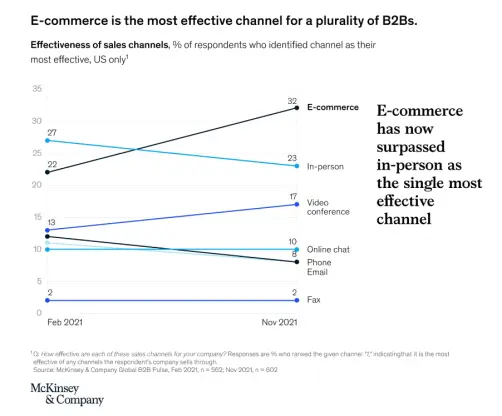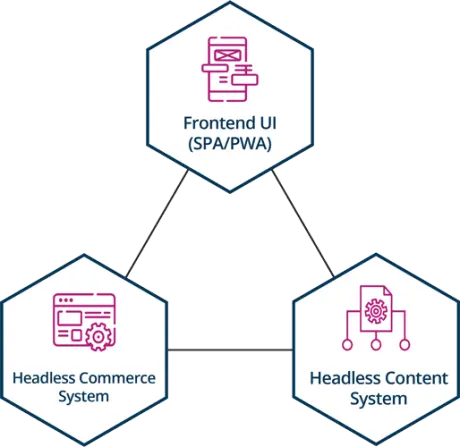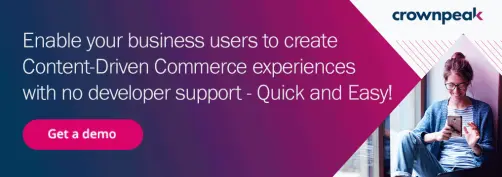Why Headless Content-Driven Commerce is the Future of B2B
While the pandemic has accelerated innovation in the B2C e-commerce space, most notably with online purchasing becoming the preferred - and often only channel available - B2B is rapidly following suit. “Gartner® expects that by 2025 80% of B2B sales interactions between suppliers and buyers will occur in digital channels 1 .
Indeed, B2B is transforming so rapidly that Chiefmartec’s Scott Brinker lists Innovation in Commerce as one of his top Martech predictions for 2022. He points to new research from McKinsey which shows that e-commerce is now viewed as the most effective channel for B2B sales, with digital self-service now the most popular way for B2B buyers to make their purchases at every stage of the sales journey, including:
- Identifying and researching new suppliers (37%)
- Considering and evaluating new suppliers (34%)
- Ordering (37%), and reordering (38%)”.

As Brinker comments, “This has a ton of implications for marketing and martech, but perhaps the greatest is the opportunity for direct Marketing-Generated Revenue.” Indeed, as we discuss in our ebook: Why Marketing-Driven Digital Experiences Will be the Growth Lever for B2B - the trend toward digital buying is creating enormous competitive opportunities for B2B organizations to create superior, personalized digital buying experiences, supporting their customers through the buy-cycle across their preferred channels of interaction.

The opportunity is here now, however, many B2B organizations are finding themselves restricted by their slow-moving, legacy e-commerce platforms.
The best way to engage customers via digital channels is to provide content that is compelling, useful and personalized – what we like to call taking a content-driven approach. And the best, most adaptable and future-proof way to deliver that content is via a hybrid headless content-driven platform.
In this post we look at the benefits of using a content-driven approach, the challenges posed by traditional monolithic e-commerce technologies, and how modern, composable, headless architectures are the future of B2B commerce.
Next-generation B2B shopping experiences - why content is king
With the B2B commerce revolution in full swing, content-driven commerce strategies are one of the hottest trends. In B2B, sales decisions are often significantly more complex and high stakes than B2C, and with 2/3 of B2B buyers now opting for remote interactions or digital self-serve , it has become critical for companies to find new and better ways to support the sales process online. And the opportunities are substantial, with 35% of buyers willing to spend big through online sales channels - $500,000+ or more in a single transaction (up from 27 percent in February 2021) .
Customer experience is often named the most important factor for a successful e-commerce business. According to PwC, “ Experience is everything ”- 73% of customers state that experience helps to drive their buying decision. A content-driven commerce strategy focuses on delivering the optimum customer experience throughout the customer journey: from first contact through the buying process and after the sale has closed. This includes embedding product information within consumable, media-rich content such as interactive images and shoppable videos that make your product catalog come to life, and supporting the buying decision with evaluation tools such as product comparisons, demonstrations and use cases.
The problem with monolithic e-commerce architectures
Over the last 20 years, the market has been dominated by monolithic e-commerce platforms. The monolithic or ‘full stack’ approach, where front- and back-end systems are tightly coupled, made sense back in the day when e-commerce sites only had to cater to one experience – the desktop. But now, e-commerce experiences must be available across a variety of platforms and digital channels, and customers are also demanding richer, personalized experiences which exceed the capabilities of legacy systems.
Due to their archaic architectures, monolithic platforms are slow to adapt to market demands and the fast-changing technology landscape, and their costly, high-maintenance infrastructures can consume a significant portion of organization’s marketing budgets. They also require significant time and support from developers to add content and deliver campaigns.
- 1. Business users such as e-commerce managers and marketers want to create inspirational, personalized content and campaigns quickly and easily, without the need to involve IT. However monolithic e-commerce platforms are often lacking in the latest capabilities or prove too complex and cumbersome for business users to operate directly. These systems have grown over the years and often rely on legacy code or infrastructure. Adding features or changing existing processes requires very specific know-how and a lot of quality assurance caused by complexity and the dependencies to legacy technology.
- 2. Developers need a system which can be easily maintained and adapted to the organization's needs without long onboarding periods, training and expensive implementation efforts. Developers often struggle with making changes to monolithic platforms and updates and maintenance can be time-consuming and very costly.
Why the future is composable
To support business users and developers, analysts, are mandating a shift from monolithic e-commerce platforms to more agile, composable or “best-of-breed” systems. Gartner states:
““Application leaders responsible for digital commerce should prepare for a “composable” approach using packaged business capabilities to move toward future-proof digital commerce experiences.”2”
For any company wanting to deliver true omnichannel, content-driven experiences a composable commerce approach is necessary to support agility today while future-proofing the approach for a fast-changing consumer and technology landscape.
So what are the key ingredients of a composable e-commerce architecture?
Think of the architecture as a triangle comprising a headless e-commerce system, a frontend UI (PWA / SPA) solution and a headless Digital Experience Platform (DXP).

In this structure, rather than being locked into a single monolithic provider, organizations have the advantage to select from a wide range of best-of-breed solutions to create the ideal ecosystem to support their needs.
1. Headless Commerce System
If you’re starting fresh, this is a great opportunity to choose a next-generation headless e-commerce system , with composability baked into its DNA. This approach simplifies integration and is highly scalable to change as your company evolves.
However, if your company is starting with an existing monolithic e-commerce system, the simplest approach may be to stay with your current e-commerce solution and add a DXP and PWA vendor. In this case the DXP vendor will need to offer a flexible integration to your e-commerce platform and offer headless capabilities.
2. Frontend UI (PWA / SPA)
Using a Progressive Web App (PWA) or Single Page Application (SPA) for the frontend is a well-established solution for managing the commerce experience. These solutions enable the CX to be managed and controlled with greater flexibility compared to using monolithic e-commerce platforms. They also enable developers to leverage the latest technologies of their choice and add features or adapt changes faster.
Here are some examples of the options available:
- Some headless DXP vendors, such as Crownpeak, offer pre-built PWA solutions
- Many e-commerce vendors offer pre-built PWA solutions. Examples include Spartacus from SAP, and Salesforce’ acquisition of headless storefront solution Mobify .
- There are also Frontend-as-a-Service (FEaaS) providers like Vue Storefront or Frontastic
The best solution will depend on the unique requirements of your organization, but since the goal is to create a content-driven solution leveraging your DXP’s PWA is often the most effective path to delivering on your CX and content strategy.
3. Headless DXP or CMS
The third corner of the triangle is the key to delivering the enhanced content-rich customer experiences that will enable you to strengthen customer engagement and turn shoppers into loyal customers.
With most of the modern headless e-commerce systems available, creating inspiring experiences still often requires a lot of support from developers. However, by partnering the e-commerce solution with a headless Digital Experience Platform (DXP) or Enterprise Content Management System (CMS), e-commerce managers and marketers can easily create personalized, multi-channel experiences for their customers quickly and easily, without the need for IT or developer support.
Putting the DXP in the driver’s seat
Moving from a monolithic to a composable, headless approach is the first step to enabling the entire organization to act faster and react quickly to changing customer and business needs.
However, commerce platforms alone won't deliver the omnichannel experiences today’s customers expect when shopping, whether online or in-store. By partnering headless commerce with a headless DXP solution, e-commerce managers and marketers can take command of the commerce experience, delivering inspiring and high-converting e-commerce experiences that build competitive edge.
In moving from a monolithic solution - where one system controls everything – to a composable architecture, a new question arises: Which is the primary system in the triangle?
Traditionally, e-commerce systems were considered primary, but as organizations move from a transaction-driven to a content-driven approach, the DXP is increasingly viewed as the lead platform.
A hybrid headless content-driven platform approach offers B2B retailers innovative options that are easy for marketing managers to use and allows them to create an environment that helps turn customers into loyal shoppers who advocate for the brand. The content-driven focus helps retailers focus on storytelling and creating inspiring experiences, not just selling products.
In our next post, we’ll dive into the top five drivers to adopt a content-driven commerce approach and how it is enabling B2B organizations to generate increased revenue, improve customer loyalty and provide a better customer experience.
To learn more about creating content-rich shopping experiences with Crownpeak, speak to an expert today .

1 Gartner, “The Future of Sales: Transformational Strategies for B2B Sales Organizations” , Gartner for Sales, Published 2020.
2 Gartner, "Composable Commerce Must Be Adopted for the Future of Applications" , Mike Lowndes, Sandy Shen, Published 18 June 2020,
Gartner is a registered trademark and service mark of Gartner, Inc. and/or its affiliates in the U.S. and internationally and is used herein with permission. All rights reserved.